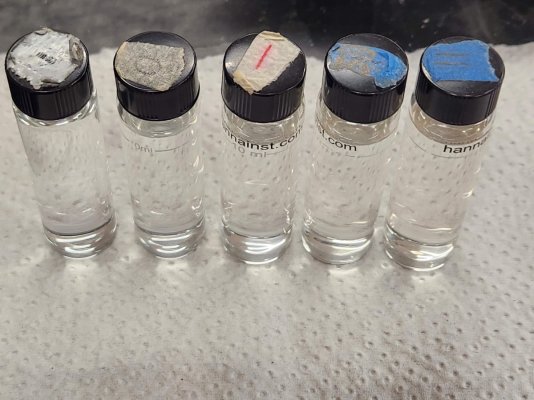I recently ran across an interesting document on the Fauna Marin site. It deals with a method that they suggest can help test the amount of phosphate deposits that are bound to the substrate surfaces of the tank. This sounds like something that I could use as I have always wondered how much more bound phosphate has yet to be released while I am actively lowering PO4 with LaCl. When I am trying to lower my PO4 levels, I operate a LaCl reactor 24x7 over many months, until I get the PO4 slowly lowered back into my target range.
I performed the test this morning during my daily tests. I was expecting to see a very high result. The tank has been sitting at about 0.23 ppm recently. It is a bit higher today (0.248 ppm) as my LaCl reagent ran out sometime between Friday and Saturday afternoon, when I noticed it and replenished it.
Heat Test 91 ppb / Normal test 81 ppb = 1.12 ratio
So my result shows very little released (bound) phosphate. Not what I was expecting to see. It's possible that my active 24x7 of LaCl may be impacting the result. I attempt to pull out the newly released, along with the daily added amount from food, fast enough to stay ahead of the increase and get a gradual decrease in phosphate as a result. If the test is being impacted by my use of LaCl, that actually might be even more useful to me, as it would provide feedback on matching my reduction process, compared to the release process of bound phosphate.
I would be interested to see anyone else's results, especially if you are not using phosphate absorbers currently. Also everyon'e view on the premise of this test.
The FM Heat Test document link is below:
https://www.faunamarin.de/wp-content/uploads/2021/04/FM_HTU_Hitzetest_EN_NEU_210421.pdf
I performed the test this morning during my daily tests. I was expecting to see a very high result. The tank has been sitting at about 0.23 ppm recently. It is a bit higher today (0.248 ppm) as my LaCl reagent ran out sometime between Friday and Saturday afternoon, when I noticed it and replenished it.
Heat Test 91 ppb / Normal test 81 ppb = 1.12 ratio
So my result shows very little released (bound) phosphate. Not what I was expecting to see. It's possible that my active 24x7 of LaCl may be impacting the result. I attempt to pull out the newly released, along with the daily added amount from food, fast enough to stay ahead of the increase and get a gradual decrease in phosphate as a result. If the test is being impacted by my use of LaCl, that actually might be even more useful to me, as it would provide feedback on matching my reduction process, compared to the release process of bound phosphate.
I would be interested to see anyone else's results, especially if you are not using phosphate absorbers currently. Also everyon'e view on the premise of this test.
The FM Heat Test document link is below:
https://www.faunamarin.de/wp-content/uploads/2021/04/FM_HTU_Hitzetest_EN_NEU_210421.pdf


















